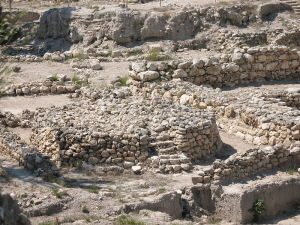
Archaeologists are now onsite at Tel Megiddo, in northern Israel, to continue large-scale excavations at what has often been called the “crown jewel” of archaeological sites of the Levant, or Eastern Mediterranean region.
Led by well-known archaeologists Israel Finkelstein of Tel Aviv University and Eric Cline of the George Washington University, a team of archaeologists, students, volunteers and other specialists will be excavating where they left off in 2012, when they encountered a large building featuring 18 pillars dated to the Iron Age IIA period, (around 1000 BCE). South of the building they uncovered a hoard of six iron daggers and two bronze bowls, dating to the Iron Age I (1200 – 1000 BCE).
Tel Megiddo, a World Heritage site, is best known for the remains of a large Canaanite center that once ruled at a location strategically placed at one of the most important military and trade routes in the ancient Near East, the Via Maris, dominating trade and commercial traffic for over 6,000 years beginning around 7000 BCE. The city is often mentioned in ancient literature and documents such as the Hebrew Bible and the el-Amarna letters of ancient Egypt, particularly as the site of epic battles that changed the course of ancient history in the region. As the inspiration for James Michener’s novel, The Source, the site affords a layer-cake of remains of ancient civilizations that came and went at the location, each succeeding civilization building upon the ruins of predecessors. This has created a treasure for archaeologists and their sponsors, who for decades have been unearthing monumental temples, palace complexes, massive fortifications, and sophisticated water systems, adding to our understanding of Bronze Age and Iron Age settlement and lifeways in the Levant. Some of the major finds of recent seasons have included a hoard of gold, silver and bronze jewelry, all wrapped in fabric and hidden in a vessel dated to around 1100 B.C.; and an Early Christian prayer hall with a mosaic floor discovered at a prison site near the Tel.
____________________________________
 The Iron Age city gate at Megiddo, one of the main attractors for toursits at the site. Golf Bravo, Wikimedia Commons
The Iron Age city gate at Megiddo, one of the main attractors for toursits at the site. Golf Bravo, Wikimedia Commons
______________________________________
 Model of Megiddo in its ancient fortified glory. Alma Guinness, Wikimedia Commons
Model of Megiddo in its ancient fortified glory. Alma Guinness, Wikimedia Commons
___________________________________
For the 2014 season, archaeologists will continue work on the pillared structure exposed in 2012; expose some late Middle Bronze Age (1800 – 1540 BCE) domestic architecture; continue to excavate parts of the early Middle Bronze Age fortification system which includes a massive mudbrick wall and glacis (defensive slope construction); study areas related to Late Bronze-Iron Age street levels; expose more of the Late Bronze Age levels excavated previously; and conduct exploratory soundings in three new locations.
The Tel Megiddo Expedition offers one of the best field school and excavation experiences for students and volunteers in the Levant. More information about the Expedition and the field school can be obtained at their website.
____________________________________
Cover Photo, Top Left: The Megiddo altar. James Emery, Wikimedia Commons
____________________________________________
Read about the most fascinating discoveries with a premium subscription to Popular Archaeology Magazine. Find out what Popular Archaeology Magazine is all about. AND MORE:
On the go? Purchase the mobile version of the current issue of Popular Archaeology Magazine here for only $2.99.
Popular Archaeology’s annual Discovery Edition eBook is a selection of the best stories published in Popular Archaeology Magazine in past issues, with an emphasis on some of the most significant, groundbreaking, or fascinating discoveries in the fields of archaeology and paleoanthropology and related fields. At least some of the articles have been updated or revised specifically for the Discovery edition. We can confidently say that there is no other single issue of an archaeology-related magazine, paper print or online, that contains as much major feature article content as this one. The latest issue, volume 2, has just been released. Go to the Discovery edition page for more information.





